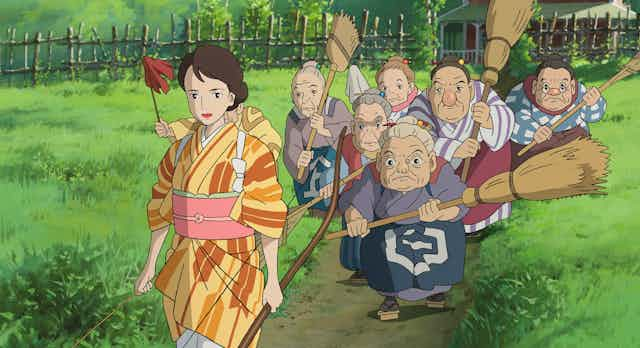In the official pamphlet sold at Japanese cinemas for The Boy and the Heron, its 82-year-old director, Hayao Miyazaki, expresses concerns about his age: “Clearly, I believe the biggest problem is that the director is long in the tooth.” He needn’t have worried.
The Boy and the Heron is Miyazaki’s masterclass in cel animation. This hand-drawn, traditional style – made by layering hand-painted images on celluloid on top of exquisite, painted backdrops – is Studio Ghibli’s signature. And in The Boy and the Heron, Miyazaki brings over half a century’s worth of his animated masterpieces together into a single coming-of-age story.
The Boy and the Heron will be available for UK audiences on October 8 and 15, as part of the BFI London Film Festival, before its cinematic release on December 8.
The film is loosely adapted from Genzaburō Yoshino’s manga, How Do You Live? (1937), which was given to Miyazaki by his mother when he was a child. As this may well be his last film for Studio Ghibli, Miyazaki uses the story to play with memory, nostalgia and the animated form.
Miyazaki has a habit of retiring, having repeatedly done so since the release of Princess Mononoke in 1997, but The Boy and the Heron feels like an homage to his history in animation. As the official brochure explains, Miyazaki intends for audiences to see it as an “autobiographical fantasy”.
Exaggerating the young Miyazaki’s experience, The Boy and the Heron begins with the death of its protagonist’s mother, setting up a story in which the young boy, Mahito, learns to become heroic and accept those around him.
Miyazaki’s own mother, Yoshiko Miyazaki, suffered from tuberculosis during his early life and died as he worked on his first film for Studio Ghibli, Castle in the Sky (1986). Miyazaki paid homage to her in that film through the character of Ma Dola, the fearless matriarch of a sky pirate family.
In The Boy and the Heron, Miyazaki returns more mournfully to this loss. In a heartbreaking sequence early in the film, Mahito runs to aid his mother as the hospital where she works burns uncontrollably. Miyazaki’s skill at representing elemental forces sings from every frame. The gently falling, still-burning soot and the heat distortions that surround Mahito as he sprints to the hospital deepen his fear and impending sorrow.
Entering Heron Mansion
After the loss of his mother, Mahito’s father moves them to the countryside and gives his son a surprise introduction to his new stepmother, Natsuko, who is pregnant. It is here that fairytale elements begin to creep in – not least in the seven old maids with whom Natsuko lives in their new home, Heron Mansion.

Despite the shift to Natsuko’s countryside idyll, war lingers on the fringes, echoing Miyazaki’s childhood. There are scenes of glass aeroplane canopies being brought to Mahito’s new home from his father’s factory. Miyazaki experienced similar events in his own childhood through his father’s work at the Miyazaki Airplane factory.
At Heron Mansion, Miyazaki begins to take Mahito through the looking glass. After purposefully hitting himself in the head with a rock, he hears a human voice coming from a grey heron, who implores Mahito to come with him.
When Mahito sees the grey heron-man disappearing into a mysterious tower, he is told that it was built by his great uncle, who “went strange in the head after reading too many books”. So begins Mahito’s adventure, as he follows the heron-man to strange, enchanted worlds.
Ghibli’s greatest hits
In these worlds, we see reproductions of Miyazaki and Studio Ghibli’s greatest hits. In the first, Mahito is rescued from the sea by a fisher-woman who requires him to gut a huge fish. This is one of two scenes that has caused a stir among fans in Japan, who have claimed that the film contains “creepy” imagery. The other is a moment in which the grey heron tries to induce Mahito to action by calling on frogs and fish to crawl all over him.
These moments have little effect on the young hero, but what does spur Mahito into action is the pregnant Natsuko’s disappearance. Mahito follows the heron into the world of magic and fantasy in order to save his new mother.

It is at this point that The Boy and the Heron becomes keenly attuned to the history of Miyazaki’s filmmaking. It presents worlds filled with strange, anthropomorphic creatures – this time mostly birds – in Miyazaki’s recognisable, personal style of fantasy.
We get refrains of Spirited Away (2001) when Mahito finds Natsuko in bed, surrounded by strands of paper that echo Yubaba and Zeniba’s flying paper minions. Towards the end of the film, too, we see rising seas that mimic Ponyo’s (2008) famous flooding sequence.
Even Mahito’s character design and movements contain elements borrowed from another, earlier Miyazaki hero – Ashitaka from Princess Mononoke. The abstracted backgrounds in his great uncle’s tower may also remind audiences of Yoshifumi Kondo’s Whispers of the Heart (1995).
If The Boy and the Heron is an autobiographical fantasy, as Miyazaki suggests, it works on multiple levels. It is a fantasy that echoes Miyazaki’s life but – more importantly – it is a reflection upon a life spent in animation. The film’s homage to Studio Ghibli’s greatest hits is a major part of its charm. It encapsulates the elements of fantasy that Hayao Miyazaki has used to charm audiences for more than 40 years.

Looking for something good? Cut through the noise with a carefully curated selection of the latest releases, live events and exhibitions, straight to your inbox every fortnight, on Fridays. Sign up here.

